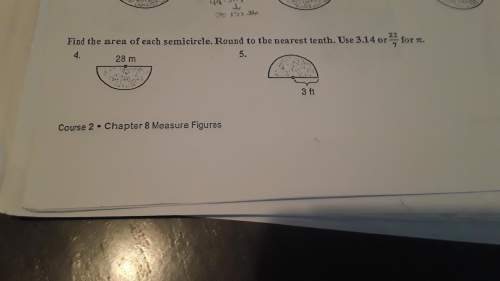
Mathematics, 10.11.2020 16:40 bigblow
Which sequence of transformations will result in a parallelogram with vertices A(−2, 1), B(−4,−3), C(2,−5), D(4,−1) A ( - 2 , 1 ) , B ( - 4 , - 3 ) , C ( 2 , - 5 ) , D ( 4 , - 1 ) being carried onto the parallelogram A'B'C'D' A ' B ' C ' D ' shown below?

Answers: 3


Another question on Mathematics

Mathematics, 21.06.2019 12:30
You will get 25 points an image of a rectangular prism is shown below: part a: a cross section of the prism is cut with a plane parallel to the base. what is the name of the shape created by the cross section? explain your answer. (5 points) part b: if a cross section of the prism is cut perpendicular to the base, what would be the shape of the resulting cross section? explain your answer. (5 points)
Answers: 1

Mathematics, 21.06.2019 18:30
It took alice 5 5/6 hours to drive to her grandparents' house for . on the way home, she ran into traffic and it took her 7 3/8 hours. how much longer did the return trip take? write your answer as a proper fraction or mixed number in simplest form. the trip home took __hours longer. ?
Answers: 1

Mathematics, 21.06.2019 20:00
Apatient is to be given 35 milligrams of demerol every 4 hours. you have demerol 50 milligrams/milliliter in stock. how many milliliters should be given per dose?
Answers: 2

Mathematics, 21.06.2019 23:00
Graph the system of equations. {6x−4y=−244x−8y=−32 use the line tool to graph the lines.
Answers: 1
You know the right answer?
Which sequence of transformations will result in a parallelogram with vertices A(−2, 1), B(−4,−3), C...
Questions

Mathematics, 25.11.2021 08:50

Physics, 25.11.2021 08:50


Chemistry, 25.11.2021 08:50


Mathematics, 25.11.2021 08:50


Physics, 25.11.2021 08:50

Mathematics, 25.11.2021 08:50


English, 25.11.2021 08:50


Mathematics, 25.11.2021 08:50

Mathematics, 25.11.2021 08:50

Physics, 25.11.2021 08:50

Mathematics, 25.11.2021 08:50

Mathematics, 25.11.2021 08:50

Mathematics, 25.11.2021 08:50


Social Studies, 25.11.2021 08:50




